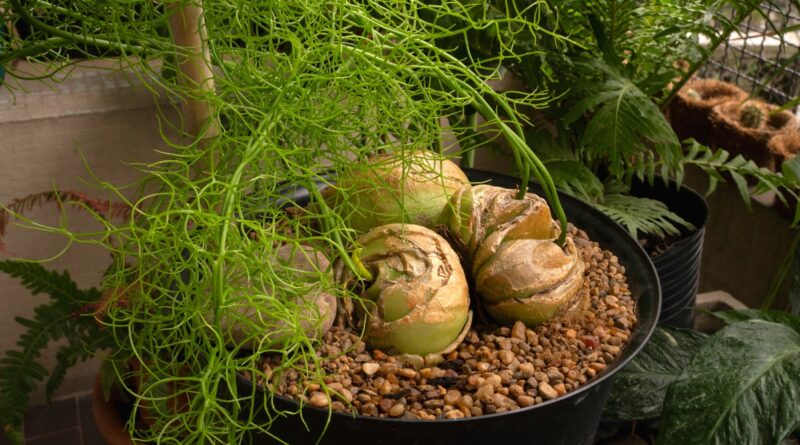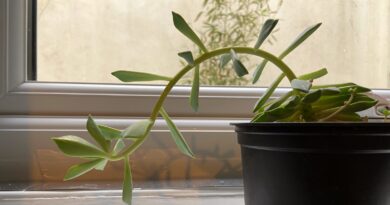How to Plant, Grow, and Care for Climbing Onion Plants
Climbing onion (Bowiea volubilis), also sometimes called Zulu potato or Bowiea sea onion, is an easy-to-grow and very unusual-looking houseplant. Despite being a member of the Asparagus family and having common names that liken it to onions and potatoes, no part of the plant is edible.
Climbing onion plants are interesting, low-maintenance houseplants. They resemble a tangle of leafless, delicate, green stems with frilly-looking tendrils emerging from a large, round, bulb-like base. When they go dormant, you are left with a fleshy, green, bulb-like base that rests quietly before awakening with fresh green growth.
All you need to grow one is a bright window, warm temperatures, a pot with good drainage, well-drained soil, and a little bit of regular watering. Once your plant is set up in a good location, it should be quite trouble-free, and you can enjoy it for many years to come.
If you’re looking for a low-fuss but high-interest plant to grow at home, consider adding a climbing onion to your houseplant collection. Let’s now dig in to learn more about their care and maintenance.
Plant Overview

|
|
|
|
Plant Natural History

Fascinating climbing onion plants are native to eastern and southern Africa’s warm, dry climates. They flourish in exposed, sunny, desert-like environments. In their natural habitat, they grow on dry, rocky hillsides, often in loose, gravelly soil.
This is a tender perennial. Depending on whether you are growing indoors or outdoors, the light and climate conditions affect the timing of lengths of dormancy. Regardless of exactly when it happens, these plants typically go dormant for a couple of months, so don’t worry if your onion vines wither and turn brown. As long as the bulb is thick and healthy-looking, it’s just saving its energy for its next growth spurt!
Despite its name, this plant is not an onion, nor is it edible. Do not try to eat it. Climbing onion is, in fact, slightly toxic and can cause mild digestive distress if any part of the plant is consumed. Do not allow your indoor pets to consume this plant, either.
Characteristics

At the beginning of their active growing season, thin, bright green vining stems emerge from the center of each bulb. Each bulb may produce a single stem, or sometimes two or three stems will sprout from a single little hole at the center of the same bulb.
The leafless stems are uniformly green and fast-growing. They loosely grow up any nearby support. As the stems lengthen and mature, side shoots develop, creating a lacy tangle of thin, delicate vegetation. Unlike many other climbing vines, however, the climbing onion does not produce twining tendrils. Instead, the vines simply entangle themselves in and around any nearby structure, occasionally gently twisting around an available holding site.
Sometime during the peak of its active growth phase, you may notice tiny, star-shaped flowers that appear singly along the stems. The flowers are almost exactly the same shade of green as the stems, making them a bit difficult to see unless you look very closely.
There is a large succulent bulb at the base of each plant. In ideal, natural conditions, this bulb can grow 15 to 20 cm across. In the home environment, bulbs are unlikely to grow more than five to 10 cm across. This bulb sits at the soil surface and makes a large, rounded, light-green, smooth mass. Older bulbs develop a thin, papery coating that resembles the skin of an onion.
Propagation
The easiest way to propagate is by division of bulbs. It is very rare for a climbing onion to produce seeds, but if it does, new plants can be started from these seeds.
Seed

If you acquire seeds from a climbing onion plant, go ahead and try to grow them! This could be a fun project, and it would be interesting to watch one of these plants develop from a tiny seed.
Place your seeds on the surface of loose, well-drained soil and cover them with a very thin layer of sand, vermiculite, or perlite. Keep the soil surface moist until the seeds germinate and start to develop bulbs.
Division

Every few years, a healthy climbing onion will produce bulb offsets. These will then grow and mature alongside the parent bulb. You do not need to divide bulbs from each other unless the pot is getting too crowded or unless you want to propagate your plants. During any time of dormancy, separate the bulbs from each other and repot them in separate pots with fresh potting soil.
To divide the bulbs, loosen the soil and remove the entire plant mass from the pot. Using your hands, gently separate the bulbs from each other. They should separate easily. Each bulb will have its own set of roots on the underside, so try to keep the roots intact on each one. Prepare pots and soil as described below and carefully replant each bulb in a fresh, clean pot with fresh soil.
Transplanting

One of the most important things to know when transplanting a climbing onion is to choose a pot with a drainage hole. It needs freely-draining soil, and the soil can’t do that without substantial holes in the bottom of the pot. Ceramic pots with drainage holes in the bottom are best because they are highly breathable.
Pot size is important with these plants. They prefer to grow in somewhat snug conditions. You can create ideal conditions by keeping them in a pot just a little wider than the bulb itself. Don’t worry about your onion outgrowing its pot too soon. They grow slowly.
The other item you will need, along with a well-draining pot, is loose soil. A soil blend designed for cacti and succulents is a great option. If you want to create your own soil mixture, combine an approximately 50/50 blend of houseplant potting soil and sand. Mix these two together thoroughly and use this as your potting soil.
How to Grow
These houseplants are very easy to grow. They need sunlight, warmth, and enough water to occasionally moisten the soil.
Sunlight

Your climbing onion needs full sun to partial shade. They also perform well indoors when grown under a full-spectrum grow light. If you grow them in a large window with direct sun exposure, move them back if you notice burns on the foliage. However, any bright window should provide plenty of sunlight.
Water

Allow the soil to dry thoroughly between waterings. After the soil has dried, give the pot a thorough watering. Then, allow the soil to dry again. After the extra water has drained out the bottom of the pot, remove the extra so the pot does not continue to stand in water.
Soil

The soil you use should be loose, sandy, and well-drained. Use cactus and succulent soil. These plants are best adapted to grow in somewhat nutrient-poor soil and do not require organic, high-nutrient soil. You don’t need to use a very deep pot either, as these plants have shallow root systems.
Climate and temperature

Climbing onion is adapted to a warm climate. The minimum temperature these plants should be exposed to is 40 to 50 degrees Fahrenheit (4 to 10 degrees Celsius). These plants tolerate both high and low humidity.
If you want to, move your potted plant outside for the summer. This would be ideal if you have a sheltered location that receives some bright light during the day. You don’t want to place it in full, direct sunlight outdoors, as this is a bit too intense for a plant used to the indoors. A shaded porch is a good choice. Bring your plant in if the temperature drops below 50 degrees Fahrenheit (10 degrees Celsius).
Fertilizing

Climbing onions are well adapted to nutrient-poor soil and do not require supplemental feeding. A typical well-drained houseplant soil mixture should provide sufficient nutrients for your plant.
If you feel that you must fertilize, do so very lightly and only during periods of active growth. Do not fertilize when your plant shows signs of dormancy and is not actively growing.
Maintenance

If your climbing onion has reproduced and created bulb offsets, you can allow them to continue growing in a clump. If your clump gets too big for the pot, however, you eventually want to divide it to make sure the pot does not become overcrowded.
The other regular maintenance is pruning. Once the plant goes dormant and the stems wither, turn brown, and die back, prune them off. Use sharp pruning snips or clean, sharp scissors and trim off the spent stems near the base, just above the bulb.
These plants like to climb, but they will also trail along. You can add a small structure to your pot for your onion to climb along. You can also allow it to trail over the edge of the pot and sprawl along beside its pot.
Another option is to grow them in a hanging basket. Some stems will probably climb up the supports for the hanging basket, while other stems will trail over the edge for a graceful green display.
Varieties
There is one species of climbing onion, Bowiea volubilis, and within this species, there are two very similar subspecies. The primary species, Bowiea volubilis, is the species most commonly encountered as a houseplant. They each have very similar characteristics and growing requirements.
Bowiea volubilis ssp. gariepensis

This species of Bowiea comes from southern Africa. It has slightly shorter and thicker stems with tiny, white, six-petaled flowers.
Bowiea volubilis ssp. volubilis

This subspecies has long, thin, many-branching stems with inconspicuous star-shaped green flowers. It is also from South Africa.
Common Problems

Climbing onion plants are generally trouble-free. As long as you don’t let your plant get too cold or too wet, you should be able to maintain a thriving houseplant for a very long and satisfying duration of time.
Root Rot – It is easy to avoid root rot in these plants. Be careful to avoid overwatering. Allow the soil to dry out completely between waterings.
If the soil stays wet, your climbing onion is likely to develop root rot as the plant experiences water stress and fungal pathogens attack. If you notice that the bulb has turned soft and mushy, this is a sure sign that rot has settled in. The simplest way to deal with root rot is to prevent it.
Frequently Asked Questions
This may not be the most common houseplant available, but you will occasionally see them for sale at greenhouses and nurseries alongside other houseplants. You can also find them online from specialty growers. If you happen to know someone with a plant, ask if they have an extra bulb they could share with you. When it matures and produces offsets, you can share them with your friends.
A well-cared-for climbing onion can be a very long-lived houseplant! They can easily live 10 years or more. In fact, as you continue to divide the bulb offsets, you can essentially keep your plant growing indefinitely.
If you live in plant hardiness zones 10 or 11, you can grow these plants outside year-round. When they go dormant outdoors in a warm climate, cover them with a thin layer of loose mulch to protect them from any unexpected cold. If you maintain your plants in pots, bring them inside anytime the temperatures drop below 50 degrees Fahrenheit (10 degrees Celsius).
Final Thoughts
Climbing onion plants are easy to grow, low maintenance, and make very rewarding houseplants. They don’t take up too much space, are interesting to look at, and don’t require any special treatment. As long as you have a sunny window, warm temperatures, and a little bit of space, you should be able to easily grow your own. Enjoy watching it cycle between active growth and dormancy, and keep an eye out for its tiny flowers!




